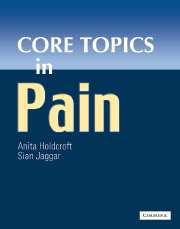Book contents
- Frontmatter
- Contents
- Contributors
- Preface
- Acknowledgements
- Foreword
- General abbreviations
- Basic science abbreviations
- PART 1 BASIC SCIENCE
- 1 Overview of pain pathways
- 2 Peripheral mechanisms
- 3 Central mechanisms
- 4 Pharmacogenomics and pain
- 5 Peripheral and central sensitization
- 6 Inflammation and pain
- 7 Nerve damage and its relationship to neuropathic pain
- 8 Receptor mechanisms
- PART 2 PAIN ASSESSMENT
- Section 2a Pain measurement
- Section 2b Diagnostic strategies
- PART 3 PAIN IN THE CLINICAL SETTING
- Section 3a Clinical presentations
- Section 3b Pain syndromes
- PART 4 THE ROLE OF EVIDENCE IN PAIN MANAGEMENT
- PART 5 TREATMENT OF PAIN
- Section 5a General Principles
- Section 5b Physical treatments
- Section 5c Pharmacology
- Section 5d Psychosocial
- PART 6 SUMMARIES
- Glossary
- Index
5 - Peripheral and central sensitization
from PART 1 - BASIC SCIENCE
Published online by Cambridge University Press: 10 December 2009
- Frontmatter
- Contents
- Contributors
- Preface
- Acknowledgements
- Foreword
- General abbreviations
- Basic science abbreviations
- PART 1 BASIC SCIENCE
- 1 Overview of pain pathways
- 2 Peripheral mechanisms
- 3 Central mechanisms
- 4 Pharmacogenomics and pain
- 5 Peripheral and central sensitization
- 6 Inflammation and pain
- 7 Nerve damage and its relationship to neuropathic pain
- 8 Receptor mechanisms
- PART 2 PAIN ASSESSMENT
- Section 2a Pain measurement
- Section 2b Diagnostic strategies
- PART 3 PAIN IN THE CLINICAL SETTING
- Section 3a Clinical presentations
- Section 3b Pain syndromes
- PART 4 THE ROLE OF EVIDENCE IN PAIN MANAGEMENT
- PART 5 TREATMENT OF PAIN
- Section 5a General Principles
- Section 5b Physical treatments
- Section 5c Pharmacology
- Section 5d Psychosocial
- PART 6 SUMMARIES
- Glossary
- Index
Summary
In the presence of an ongoing stimulus, most of the special senses adapt to reduce our perception of the stimulus. For example, olfactory receptors adapt to persistent odours, Pacinian corpuscles adapt completely to constant pressure, and visual receptors (rods and cones) adapt in bright light conditions. In contrast, no real adaptation is shown by nociceptors and, in fact, the opposite happens. In the presence of a repeated noxious stimulus, such as occurs during tissue injury, the perceived intensity of the painful stimulus is much enhanced — a phenomenon referred to as hyperalgesia — and this spreads to surrounding undamaged areas. In addition, normally non-noxious stimuli can be perceived as painful — allodynia. These phenomena are of obvious evolutionary importance, forcing rest of the damaged area until it is healed. But today we want to control such pain, for example to improve post-operative recovery, and to do so we must understand the underlying processes. Importantly, these basic mechanisms also underlie hard-to-treat pain conditions that outlive tissue damage or that occur without apparent cause, for example cancer pain and neuropathic pain.
Two processes contribute to hyperalgesia and allodynia: peripheral sensitization of nociceptors, where events around the damaged site combine to allow a lower intensity stimulus to evoke an action potential in the fibre, and central sensitization, where changes occur in the spinal processing of primary (1°) afferent inputs, continuing hyperalgesia and enlarging the area of hyperalgesia and allodynia.
- Type
- Chapter
- Information
- Core Topics in Pain , pp. 29 - 36Publisher: Cambridge University PressPrint publication year: 2005
- 1
- Cited by

